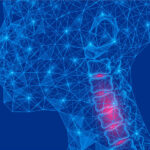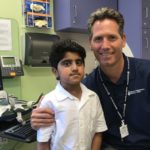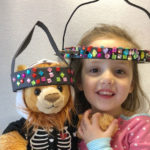A fall from a swing uncovers a rare cervical spine condition: Charlotte’s story
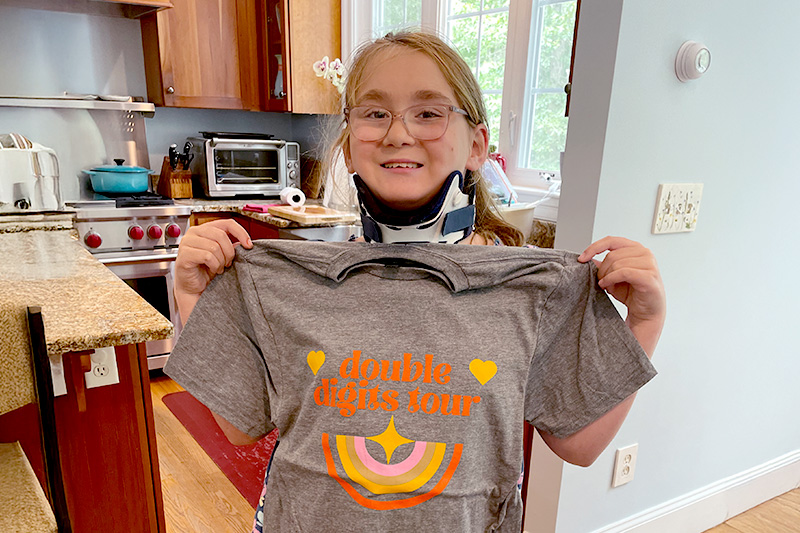
If it were any other year, Charlotte Gillis would have celebrated her 10th birthday in mid-July with a big party. But in June 2024, a fall from a swing had left her temporarily paralyzed. Though her mobility returned within a few hours, she was still in a neck brace, still wobbly on her feet, and still had pins and needles that made walking painful several weeks later. With her birthday looming, she was scheduled for spine surgery in late July.
“I’m worried about the party,” she confided to her mother, Karen. By then, Charlotte had been diagnosed with os odontoideum, a condition that causes instability of the cervical spine. When she’d fallen from the swing, a vertebra in her neck had pinched her spinal cord. Normally she would have loved spending the day surrounded by her sister, cousins, aunts, uncles, and grandparents. But now she worried that someone might accidentally bump into her.
So, her family got creative. In the spirit of Taylor Swift’s Eras Tour, they planned Charlotte’s Double Digits Tour. Rather than one big gathering, her extended family and friends threw a series of mini parties in their homes, channeling their nervous energy into treating Charlotte like a superstar. They even got concert T-shirts with each stop of her two-week tour printed on back.
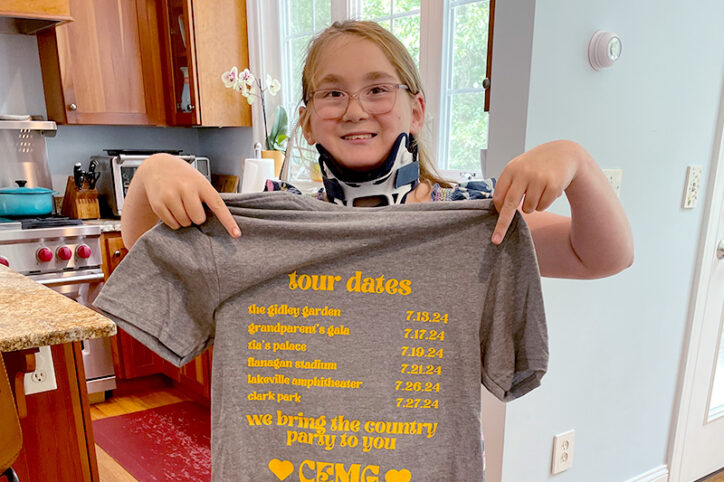
Short fall, long aftermath
“We were living a normal life,” says Charlotte’s father, David, of the day she fell backwards off a swing in the back yard. When she didn’t respond to his call, he’d found her on the ground, unmoving. By the time she arrived by ambulance at the nearest emergency department, she could move again. However, she had pins and needles throughout her body. A CT scan showed that her spinal cord was bruised, but no one could tell her parents why.
When they got the news, three weeks later, that Charlotte had a break in her C2 (a vertebra at the top of the spine) and needed surgery to fix it, Karen and David reached out to their network, including several medical specialists whom Karen knew professionally. “Every one of them called back with the same advice,” she says. “‘Get in touch with the complex spine program at Boston Children’s.’”
The right place for Charlotte
The Complex Cervical Spine Program treats children with conditions like os odontoideum that require expertise in neurosurgery and orthopedic spine surgery. From their first conversation with program coordinator Emma Hartman, Karen and David’s anxiety over their daughter’s condition started to give way to relief.
“Emma was calm, sensitive, and knowledgeable,” says David. Even better, she did what she said she was going to do. “She took our information, and they were on it.” Finally, they felt, they’d found a team who would give them reliable information about their daughter’s condition and had a plan to address it.
Soon, David and Karen were on a Zoom call with neurosurgeon Dr. Mark Proctor. Having reviewed images of Charlotte’s spine, he told them she might have been born with os odonotoideum or a prior trauma could have caused it, but her fall from the swing had triggered it. He also told them how he and spine surgeon Dr. Daniel Hedequist would stabilize her spine.
The operation would take place in two stages. First, Dr. Proctor would decompress Charlotte’s spinal cord and reposition any vertebrae that had shifted out of place. Then Dr. Hedequist would place rods and screws to hold the unstable vertebrae in place. Over the course of several months, these vertebrae would fuse into solid bone. In the end, Charlotte would be able to return to her active life without fear of a repeat occurrence.
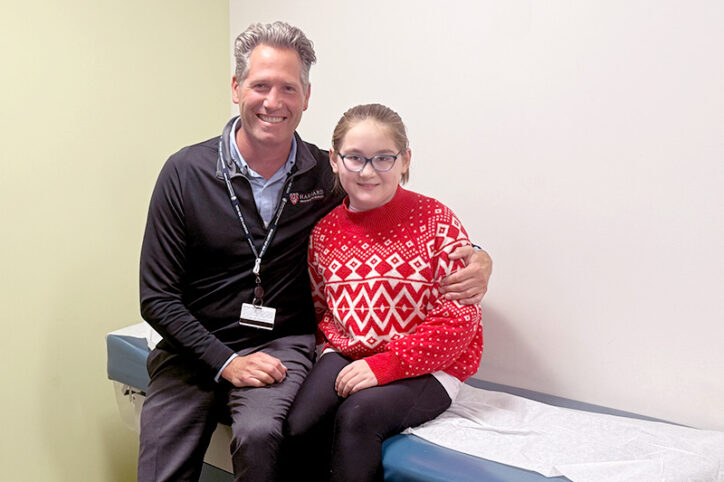
Karen and David had by then read several academic papers by Drs. Proctor and Hedequist on os odontoideum and felt they’d found the right place for Charlotte. But first, Charlotte wanted to look both surgeons in the eyes. “I want to see if they seem smart,” she told her parents. After virtual meetings with both surgeons, she too felt confident in their abilities.
Stabilizing Charlotte’s cervical spine
The surgery took more than five hours. As Karen and David waited, a member of the surgical team emerged every hour to update them on their progress. When it was over, Dr. Hedequist came out and told them the surgery had gone well, exactly as planned. “That was great, great news,” says Karen.
For the next four days, as Charlotte recovered in the hospital, she received daily visits from both of her surgeons. She went home with instructions from Dr. Hedequist about how careful they needed to be to allow Charlotte’s neck to heal.
Finally, in early December, the family returned to Boston Children’s. After an exam and review of her latest images, Dr. Hedequist told Charlotte she could say goodbye to the neck brace for good. When she felt ready, she could return to full activity.
Charlotte jumps in
In celebration, the family took a vacation after Christmas so they could all relax and play in the waves. It took several days for Charlotte to build up her confidence, says David. “But by day seven, she was jumping off of rafts and being a kid again.” And when she returned to school, she returned to fully participating in her school’s physical education program.
Looking back, Karen and David feel fortunate to have found the program that helped Charlotte reclaim her life as an active 10-year-old. “We wanted to find the best place in the world to treat Charlotte,” says Karen. “From the minute we walked in the door at Boston Children’s, and with every single person we interacted with there, we knew we’d found that place.”
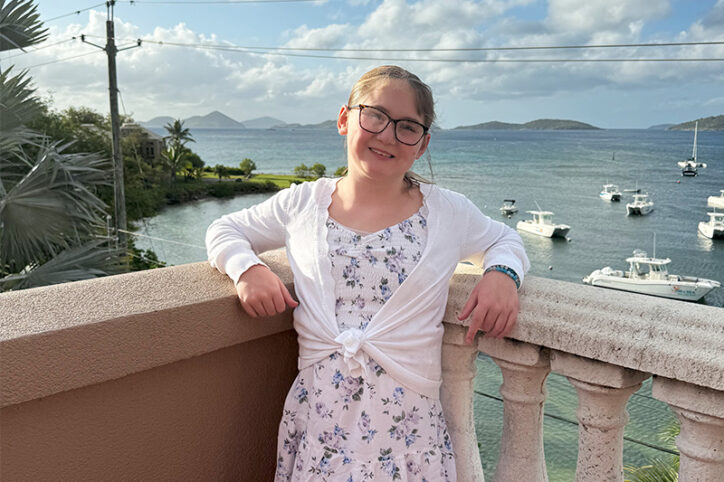
Learn more about the Complex Cervical Spine Program.
Related Posts :
-

In cases of pediatric cervical spine instability, two attending surgeons are better than one
Cervical spine instability (caused by congenital deformity, trauma, or a tumor) can affect children in a number of ways: from ...
-

Everli: Living her best life after atlantoaxial instability
When they travelled to the orphanage in China in early 2018, Shannon and Matt Gottschalk knew the toddler they hoped to ...
-

Saif looks ahead to life after spine surgery
Saif and his mother, Khawha Abbas, both had questions for Dr. Daniel Hedequist. For the past nine months, the family ...
-

Gracie’s complex spine
Halloween 2018 was no ordinary ghouls’ day for Gracie Neef. She and both her parents dressed up as the witches from “...


